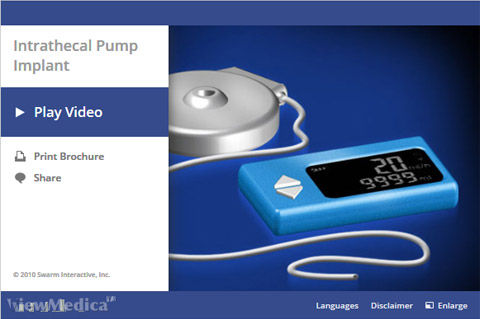Treatments
8. Intrathecal / Spinal Pump
Objective: Pain relief and more precise control of drug dosage. This reduces the amount of oral medications you need to take, which also reduces the drugs’ side effects. You generally need about 1/300 the amount of morphine or baclofen with a pump than when taken orally. Indicated for: Patients dependent on pain medication, for whom traditional methods/surgeries and conservative therapies have not worked.
Situations that stand to benefit from this treatment include: 1. Failed back surgery syndrome (failure of one or more surgeries to control persistent leg pain, i.e. sciatica, but not technical failure of the original procedure). 2. Cancer pain (constant pain caused by tumors compressing the spinal nerves, or scarring from previous radiation therapy). 3. Reflex sympathetic dystrophy (a progressive disease of the nervous system in which patients feel constant chronic burning pain.) 4. Causalgia (burning pain caused by peripheral nerve injury). 5. Arachnoiditis (painful inflammation and scarring of the meninges, or protective layers, of the spinal nerves). 6. Chronic pancreatitis (chronic abdominal pain caused by inflammation or blockage of the pancreatic duct).
The pump can also lessen spasticity (muscle rigidity and spasms that make movement of the arms and legs difficult) caused by: 1. Cerebral palsy (a nervous disorder that impairs control of body movement). 2. Multiple sclerosis (a disorder of the brain and spinal cord caused by damage to the outer layer, or myelin, of nerve cells). 3. Stroke (damage to the brain from lack of oxygen; due to an interruption of the blood supply). 4. Brain injury. 5. Spinal cord injury.
Not Indicated for: Patients with psychological problems, allergies to any of the drugs used in the pump, or certain medical conditions that make implantation risky.
Pre-Treatment: Required Evaluation: Medications:
You’ll also need to undergo a trial dose of the medication and exhibit a positive response.
Treatment: Intrathecal drug delivery, or “pain pump,” is a method of delivering medication directly to your spinal cord. It is similar to the epidural that women may receive during childbirth.
We implant the pump, a round metal device about the size of a hockey puck, under the skin of your abdomen. Then, we place a catheter, or small plastic tube, in the fluid-filled space around your spinal cord (called the subarachnoid or intrathecal space) and connect it to the pump. A reservoir inside the pump holds the medication, and delivers it via the tube to the intrathecal space. This allows the medication to bypass the path that oral medication would take throughout your entire body, allowing you to control your symptoms with much smaller dosages than is needed with oral medication. This therapy is completely reversible if you ever decide to have the pump removed.
Post-Treatment: The pump is programmed with information about how much medication to release over the course of the day (and whether to release different amounts at different times of day, depending on your needs). Your doctor will review this information with the programmer. When the reservoir is empty, your doctor or nurse will refill the pump by inserting a needle through your skin and into the fill port on top of the reservoir.

